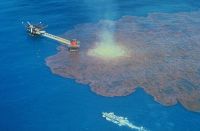Tuesday, April 16, 2024
News and Views from the Global South
Ixtoc Disaster Holds Clues to Evolution of an Oil Spill
Matthew O. Berger and Emilio Godoy*
- On a spring day in the Gulf of Mexico, a pipe issuing from the sea floor ruptured, sending an explosion rippling up to the drilling platform above and spewing oil into the surrounding waters. Experts scrambled to seal off the ever-increasing mass of oil by capping the pipe, clogging it or covering it. Nothing worked.
Work began on the drilling of a relief well. Oil continued to gush into the ecologically fragile and economically critical waters.
That was 31 years ago.
The 1979 explosion at Pemex’s Ixtoc I offshore oil rig was the worst accidental oil spill in history, releasing an estimated 140 million gallons of crude oil before the relief well could plug the leak 290 days after it began.
The amount of oil issuing from the well under the BP-owned Deepwater Horizon rig – relatively young at only 56 days old – is expected to surpass Ixtoc’s record. Some estimates say it already has.
What effect that oil will ultimately have on the surrounding environment and communities is far from clear, but the Ixtoc spill is certainly the most logical place to look for answers. Unfortunately, strikingly few studies were done in the wake of that catastrophe.
One, titled “Impacto ecológico de la industria petrolera en la Sonda de Campeche, México, tras tres décadas de actividad” (Ecological Impact of the Oil Industry in the Bay of Campeche, Mexico, After Three Decades) found that the most persistent issues were pollution of estuaries and coastal lagoons lining the bay, and especially the effects on breeding and growth of several food fish species.
Decades after the Ixtoc spill, in 2002, biologist Wes Tunnell was on a cruise in the Veracruz reefs with National Geographic.
After only 15 minutes of snorkeling there, he encountered what most snorkelers would think is just a rock or ledge, covered in sand, algae and shells - "I stuck my knife into it. When I pulled it out it was tar."
He describes this "tar blob" as inert, "just laying there," with black sediments around the base that indicated there were extremely low levels of oxygen there.
"It means there may be a little bit of impact going on right adjacent to the base of it, but on the top of it, I think it was pretty inert or sealed off there because other living things were crawling around on it and growing on it," Tunnell said."[These blobs] just continue to weather over time and get smaller and smaller."
Tunnell recently asked a friend that was on the same 2002 cruise to search for the blobs again, but "he couldn't find anything".
This week Tunnel is flying back to Veracruz himself to see what remnants - if any - are still present. "We're going to do a really good search to see if there's any left or if they're all gone, just to fill in the story," he said.
"It's a question I've had from so many people - both the public and scientists: 'Well, what happened to all of [the oil]?' For the most part, I think it's gone and we won't find much, but we're going to go back just to check and make sure."
He has studied the southern Gulf of Mexico and the Bay of Campeche – where the Ixtoc I rig was located – for about 45 years, including regular visits to certain spill-impacted localities in the 30 years since 1979.
But even he admits, “It’s pretty baffling for most of us who studied that spill to know what happened to that oil and where it all went.”
He does know a few things about its impact, though.
The blowout that led to the spill occurred on Jun. 3. Currents eventually washed the crude oil ashore in the Mexican states of Campeche, Tabasco, Veracruz and Tamaulipas. By the time it reached the south Texas coast in the first week of August, Tunnell was ready.
“Over the next six weeks it pretty much coated the south Texas beaches for about 30 miles – a 20- to 30-foot wide band of oil and tar about a half-an-inch thick to one-foot thick in some places,” he told IPS in a phone interview.
With other researchers, he had taken samples before the oil got there, in July. They returned for more studies in September, after the oil had arrived and “been stirred up by some storms”.
What they discovered was that two groups of organisms that “can be found by the thousands per metre squared in the sand beneath your feet when you’re walking along in the surf zone” – marine worms and amphipods – were reduced by 80 percent in the inter-tidal zone and 50 percent in the sub- tidal zone, though he emphasises that those numbers represent the averages of lots of different samples.
“So we didn’t see a drop in the number of species but a drop in the number of individuals. We thought ‘Oh, boy, this is really severe’,” Tunnell said.
Two and half years after the spill, he got a graduate student to go do a thesis project on the same Texas beaches. It was discovered that by then the worm and amphipod numbers had rebounded.
“So you can probably say that within two to three years the beach fauna or beach populations were back to where they were before the spill. I think that’s probably a pretty standard thing. Fine-grain, sandy beaches can be cleaned up pretty easily,” Tunnell explained.
He also recalls a colleague who had studied the shrimp fishery based in Campeche, Mexico – the largest in the southern gulf – assuming that the fishery “would be devastated for years to come” by the oil from Ixtoc.
But, he says, “The second year after the spill the shrimp populations were back to where they were before the spill, which is, again, pretty amazing to us.”
Tom Shirley, also of the Harte Institute, has some insights into why these organisms were able to bounce back so quickly.
The equivalent of an oil tanker seeps into the water from oil deposits under the sea floor each year, and organisms have adapted to cope with the constant presence of oil in the water. That coping means that the animals in the gulf have a striking capacity to break down oil molecules, Shirley said.
“So the gulf, due to these seeps, is more ready to deal with oil than most anywhere else,” he said. “[It’s] an amazingly resilient habitat.”
But, he explained, the naturally-occurring seeps happen in a much more gradual way that is likely much easier for organisms to manage and cope with than the tens of thousands of barrels in the water right now.
“As long as oil spills remain out on the open sea, the effects are relatively limited,” Daniel Lluch-Cota, a biologist at the state Northwest Biological Research Centre and one of the four authors of the 2004 study, told IPS. “The real trouble begins when they reach the shore.”
The effects on coastal flora and fauna “are serious, and include from reduced phytoplankton productivity to direct damage to seabirds and other species,” he said.
Remnants of the Ixtoc spill could still be seen and touched as recently as seven years ago, and Tunnell is setting out this week to determine whether they are still there today.
In the fall of 1979, while he was studying the impact of the oil washing up in Texas, he sent a couple graduate students to the reefs in the southern gulf, near Veracruz. They found that the oil had come in on a tropical storm and was floating over the top of the reefs where it did not directly impact them. It had, however ringed a lot of the reef islands with 12 to 15 inch-thick mats of oil.
He continued to track and map these mats, returning each June with his class. “They slowly continued to break down, particularly in the next five to six years after the spill. After that time it was pretty hard to find any remnants of the spill,” he said.Still, environmental campaigners note that no authoritative assessment has ever been made.
“We don’t know if the damage done [at Ixtoc] has been remedied. Petróleos Mexicanos (PEMEX, the state oil company) has limited capacity for cleaning up pollution,” Gustavo Ampugnani, Greenpeace International political coordinator for Latin America, told IPS.
*Emilio Godoy reported from Mexico.

 Print
Print




